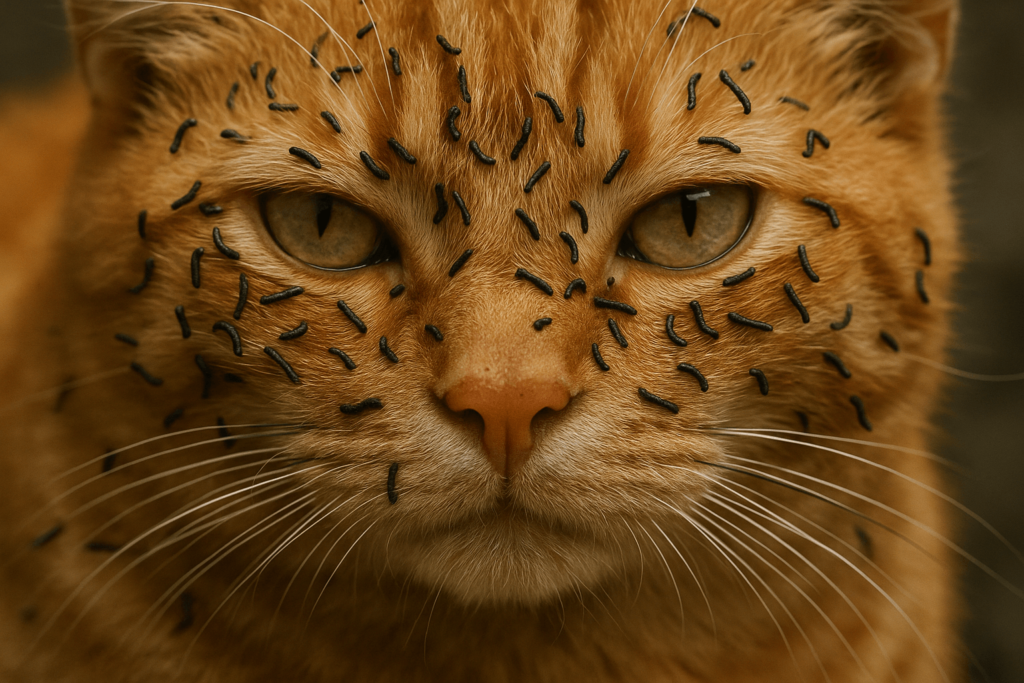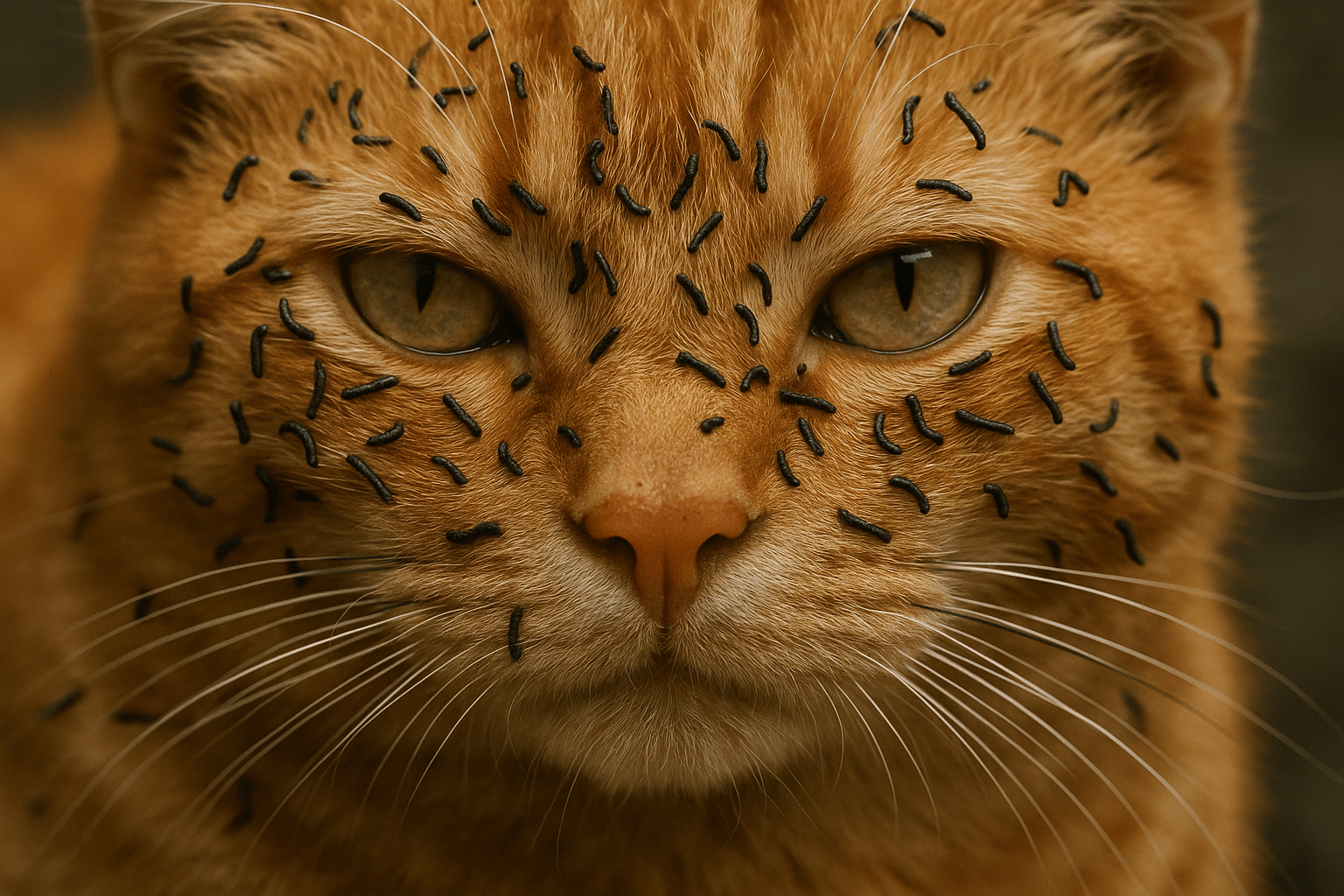Tiny Black Worms on Cat: What They Are and How to Act Fast
Seeing tiny black worms on your cat is alarming—and understandably urgent. These aren’t just unsightly; they’re a clear signal that your feline companion may be dealing with an internal or external parasite. Ignoring them can lead to serious health complications. But panic isn’t the answer—knowledge and swift action are. This guide breaks down exactly what those tiny black worms could be, how they got there, and the most effective, vet-approved steps to protect your cat and your home.
What Those Tiny Black Worms Likely Are
The presence of small, dark, moving specks on your cat’s fur, around the anus, or in their feces is rarely random. These are almost always signs of parasitic activity. Here’s what you’re likely seeing:
Tapeworm Segments:
These appear as rice-like or seed-shaped grains that may crawl slightly when fresh. They’re parts of adult tapeworms shed from the intestines.Flea Dirt (Flea Faeces):
Often mistaken for worms, this is digested blood that turns dark red or black when moistened. It’s not a worm—but a sign of fleas, which carry tapeworm larvae.Roundworm Eggs or Larvae (Rarely Visible):
While adult roundworms are long and white, eggs are microscopic. You won’t see live larvae outside the body unless in severe, untreated cases.Pinworms (Extremely Uncommon in Cats):
Pinworms primarily affect humans and dogs. If seen in cats, it’s likely misidentification—probably tapeworms or flea dirt.Maggots (In Cases of Severe Neglect or Open Wounds):
In rare, tragic cases of untreated sores or fecal contamination, fly larvae can appear. This is a medical emergency.
These signs demand immediate attention—not because they’re always life-threatening, but because they signal a deeper, treatable problem that worsens without intervention.

How Your Cat Got Infected: The Most Common Causes
Cats don’t pick up parasites by accident. There’s always a pathway. Understanding how your cat became infected helps prevent future outbreaks.
Flea Infestation:
Fleas are the #1 cause of tapeworms. When your cat grooms and swallows an infected flea, the tapeworm larva inside matures in the intestines.Eating Infected Prey:
Hunting behavior—even catching a mouse, bird, or insect—can introduce tapeworms, roundworms, or other parasites into your cat’s system.Contaminated Environment:
Soil, litter boxes, or outdoor areas where infected animals defecated can harbor parasite eggs that your cat ingests while cleaning paws or sniffing.Mother-to-Kitten Transmission:
Roundworms can pass from mother to kittens through milk or placenta. This is common in unspayed females with prior infections.Poor Hygiene or Litter Box Neglect:
A dirty litter box allows parasite eggs to thrive and increases the chance of reinfection—even after treatment.
This isn’t about blame. It’s about tracing the source. Once you know how your cat was exposed, you can break the cycle—and prevent it from happening again.
Check this guide 👉Cat Worms Identify: Best 7 Health Tips!
Check this guide 👉What Kind of Worms Can a Cat Get? Best 7 Expert Tips!
Check this guide 👉Roundworm Eggs in Cat Poop: Best 7 Expert Tips!
| Possible Cause | How It Leads to Tiny Black Worms |
|---|---|
| Flea Infestation | Fleas carry tapeworm larvae; ingestion during grooming leads to adult tapeworms shedding segments. |
| Hunting Prey | Rodents or birds may harbor tapeworm or roundworm cysts that infect cats upon consumption. |
| Dirty Litter Box | Parasite eggs survive in feces; cats re-ingest them while digging or grooming paws. |
| Mother-to-Kitten Transfer | Roundworm larvae migrate through milk or placenta, leading to visible worms in kittens’ stool or fur. |
| Outdoor Access | Contact with infected soil, feces, or carcasses increases exposure to parasite eggs and larvae. |
How to Identify the Worms Correctly (And Avoid Misdiagnosis)
Not all dark specks are worms. Misidentifying them delays proper treatment. Here’s how to tell the difference.
Tapeworm Segments:
Look for small, flat, cream-to-yellowish segments that dry into rice-like grains. If you place one on a wet tissue, it will dissolve into a reddish smear—this is digested blood from the flea host.Flea Dirt:
Rub the specks on a damp paper towel. If they turn rusty-red, it’s flea feces—not worms. This confirms an active flea infestation.Roundworm Eggs:
These are invisible to the naked eye. If you see actual worms—long, spaghetti-like—they’re adult roundworms, not tiny black ones.Maggots:
These are larger, white, and wriggling. They appear only in open wounds or severely soiled fur and emit a foul odor.Soil or Debris:
Sometimes dirt or litter particles stick to fur and look like specks. Brush the area gently—real parasites move or cling stubbornly.
When in doubt, collect a sample in a sealed bag and bring it to your vet. Visual identification is unreliable—lab testing is the only sure way.
Immediate Steps to Take When You See Tiny Black Worms
Time matters. The longer parasites remain, the more damage they cause. Here’s your urgent action plan.
Isolate Your Cat Temporarily:
Keep them away from children, other pets, and shared furniture until you know what you’re dealing with.Do NOT Use Over-the-Counter Dewormers Blindly:
Many products target only one type of parasite. Using the wrong one wastes time and may harm your cat.Collect a Sample for the Vet:
Use a plastic bag or sealed container to bring feces or visible segments to your vet. Label with date and time.Begin Flea Control Immediately:
Even if you don’t see fleas, treat your cat with a vet-recommended topical or oral flea treatment. Tapeworms mean fleas were present.Clean Your Home Thoroughly:
Vacuum carpets, wash bedding, and steam-clean upholstery. Flea eggs and larvae hide in fabric and cracks.
These steps buy you time and prevent spread—but they’re not a substitute for professional diagnosis and treatment.
Treatment Options: What Vets Actually Recommend
Veterinarians don’t guess—they test, diagnose, and prescribe. Here’s what real treatment looks like.
Prescription Dewormers:
Praziquantel for tapeworms, pyrantel pamoate for roundworms. These are safe, fast-acting, and species-specific.Flea Prevention Protocols:
Monthly topical treatments (e.g., Revolution, Frontline) or oral chewables (e.g., NexGard Spectra) break the flea-tapeworm cycle.Environmental Treatment:
Veterinarians may recommend flea foggers or sprays for your home if infestation is widespread.Repeat Dosing:
Many dewormers require a second dose 2–4 weeks later to kill newly hatched larvae.Fecal Testing:
A microscopic analysis of stool confirms the parasite type and ensures treatment was effective.
Never use dog dewormers on cats—they can be toxic. Always follow your vet’s dosage and schedule. Even one missed dose can allow reinfestation.
Preventing Future Infestations: A Long-Term Strategy
Prevention is far easier—and cheaper—than treatment. Build a parasite-free routine for your cat.
Monthly Flea & Tick Prevention:
This is non-negotiable—even for indoor cats. Fleas hitch rides on shoes, clothing, or other pets.Regular Deworming Schedule:
Indoor cats: every 6–12 months. Outdoor or hunting cats: every 3–4 months. Ask your vet for a tailored plan.Keep Litter Boxes Clean Daily:
Scoop at least once a day. Disinfect weekly with pet-safe cleaner.Limit Outdoor Access or Use Enclosures:
If your cat goes outside, consider a catio or leash walks to reduce exposure to infected soil and prey.Avoid Raw Diets Unless Supervised:
Raw meat can harbor parasites. If you feed raw, freeze meat for 72 hours first and consult your vet.
A consistent prevention plan isn’t about fear—it’s about responsibility. Your cat depends on you to protect them.
Signs Your Cat Needs Emergency Care
Not all worm infestations are mild. Watch for these red flags that require immediate veterinary attention.
Vomiting or Diarrhea with Visible Worms:
Large numbers of worms can cause intestinal blockage or severe inflammation.Lethargy, Weight Loss, or Dull Coat:
Chronic parasitism steals nutrients and weakens the immune system.Swollen Belly (Especially in Kittens):
A “pot-bellied” appearance often signals heavy roundworm infestation.Anemia (Pale Gums or Tongue):
Hookworms feed on blood. Pale mucous membranes mean your cat is losing red blood cells.Difficulty Breathing or Coughing:
Some larvae migrate to the lungs, causing respiratory distress.
If you see any of these, go to the vet today—not tomorrow. Parasites can turn fatal in days for young, old, or immunocompromised cats.
Frequently Asked Questions About Tiny Black Worms on Cats
Can I see tapeworm eggs with the naked eye?
No. Tapeworm eggs are microscopic. You’ll only see the segments they produce—these are the visible “tiny black worms.”
Is it safe to touch the worms or flea dirt?
Handle with gloves. Some parasites (like roundworms) are zoonotic—meaning they can infect humans, especially children.
Why do the worms keep coming back after treatment?
Most likely, fleas are still in your home or on other pets. Treating the cat alone won’t work if the source remains.
Can indoor cats get tapeworms?
Absolutely. Fleas can enter through windows, on clothing, or via other pets. Indoor doesn’t mean immune.
How long does it take for deworming medication to work?
Most dewormers kill adult worms within 24–48 hours. Segments may still appear for a few days as they pass.
Embrace Prevention—Protect Your Cat Before It’s Too Late
Tiny black worms on your cat aren’t just a nuisance—they’re a cry for help. But with the right knowledge, you can turn panic into power. You don’t need to be a vet to save your cat’s life—you just need to act quickly, think clearly, and prioritize prevention. Monthly flea control, regular deworming, and a clean environment are the pillars of feline health. Don’t wait for symptoms to worsen. Don’t assume your cat is “fine” because they seem playful.
Parasites don’t announce themselves with drama—they creep in quietly, silently, and dangerously. Be the guardian your cat deserves. One small step today—applying a flea treatment, cleaning the litter box, scheduling a checkup—can mean years of healthy purrs tomorrow. Your cat’s well-being starts with you. And it’s never too late to begin.
Canned Pumpkin for Cat Diarrhea: Best 7 Expert Tips! Natural remedy to firm stools, soothe upset bellies, and support gut health safely.
Can a Cat Give You Scabies? Best 7 Expert Tips! Discover the truth about feline mites, human skin risks, and how to protect yourself—without panic.
Cat Flea vs Human Flea: Best 7 Expert Tips! Discover the truth about bites, species, and how to eliminate infestations for good.
Weird Cat Behaviors: Best 7 Expert Tips! Discover why cats do strange things—and how to understand, not punish, their instincts for a happier home.





